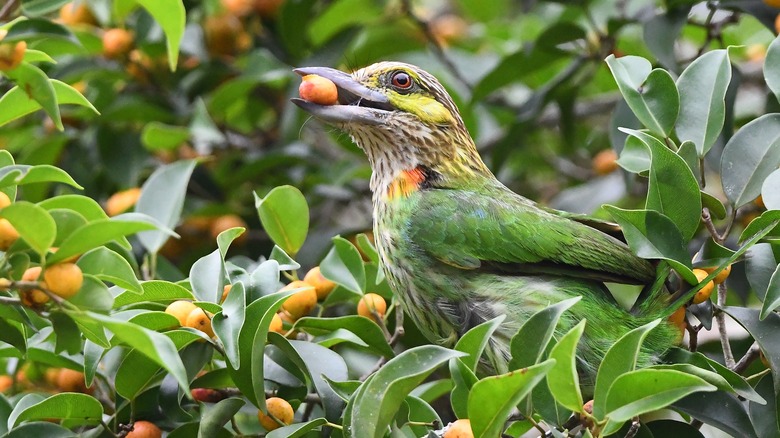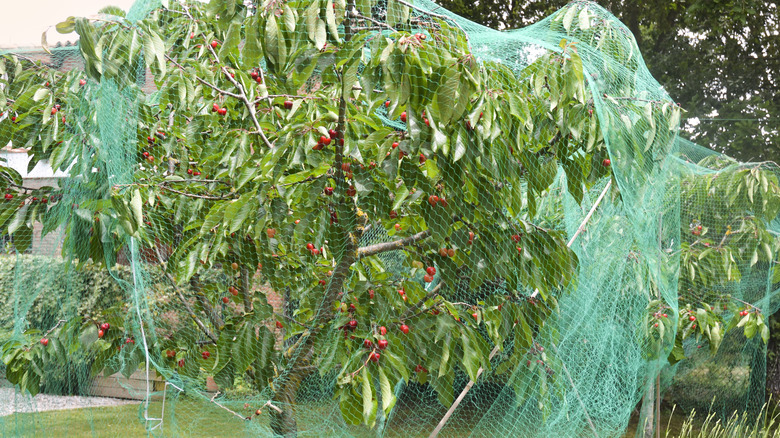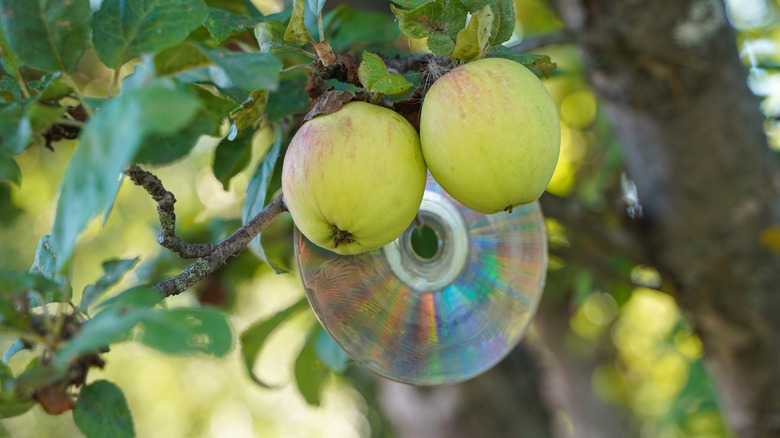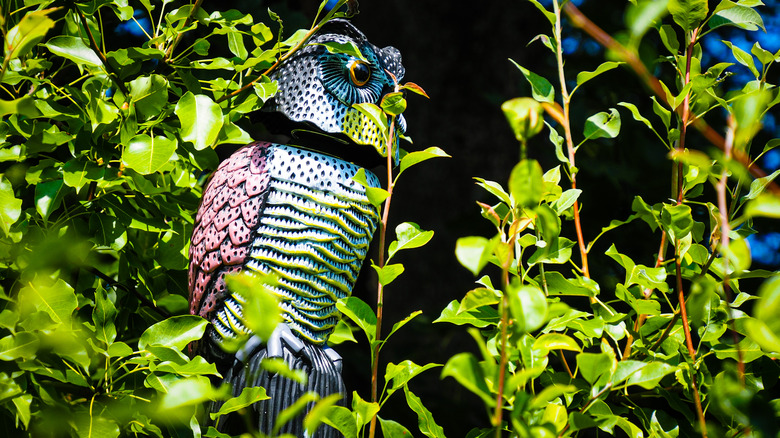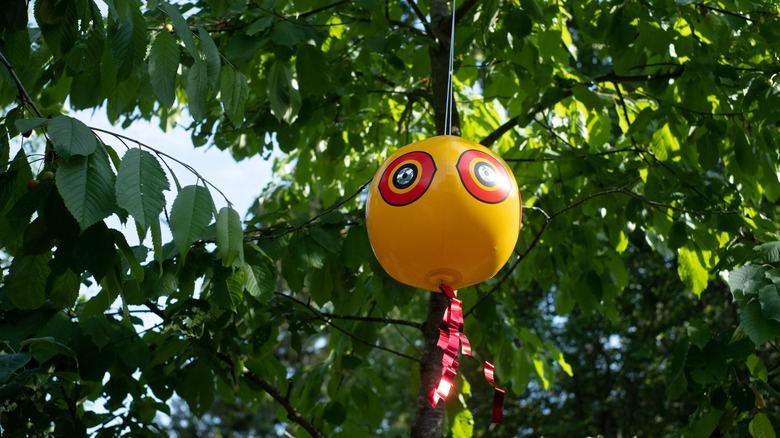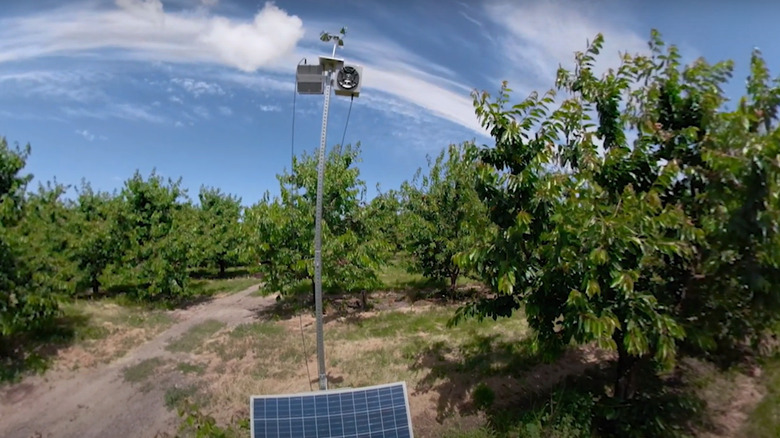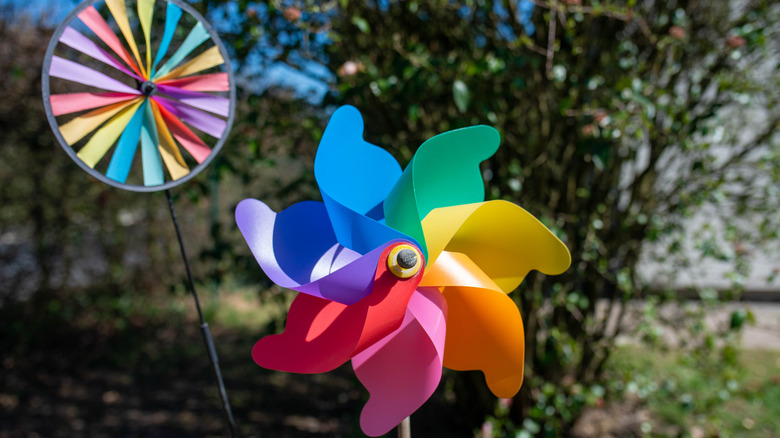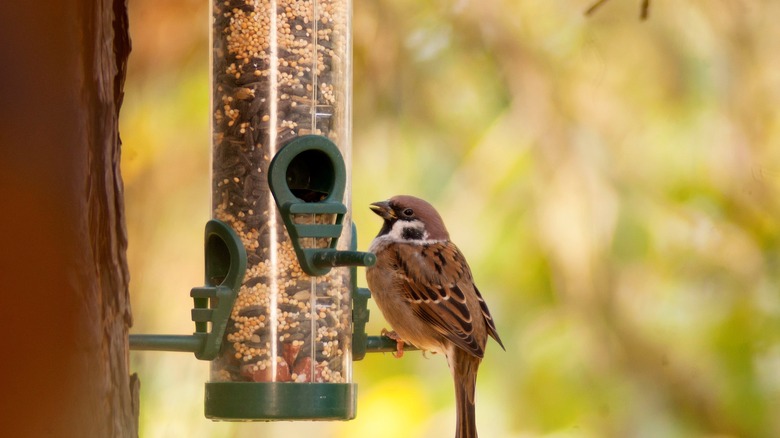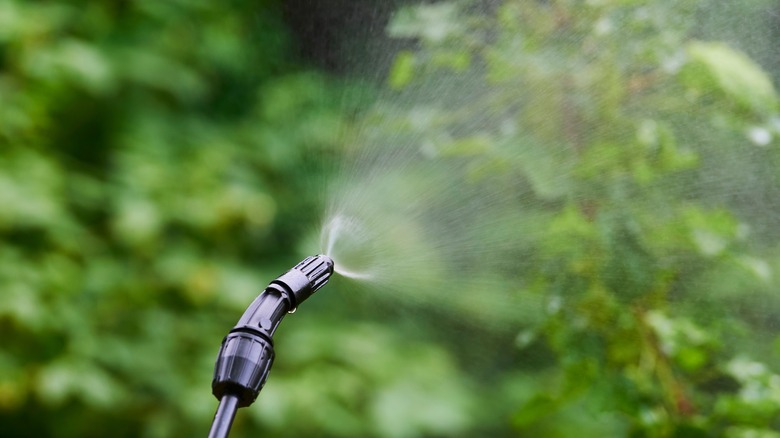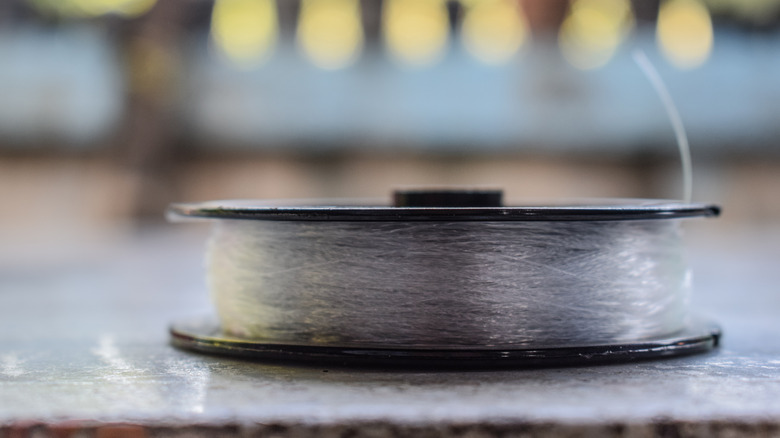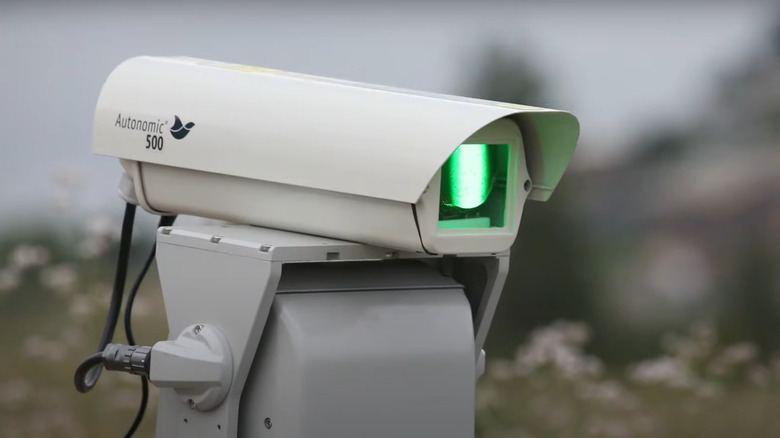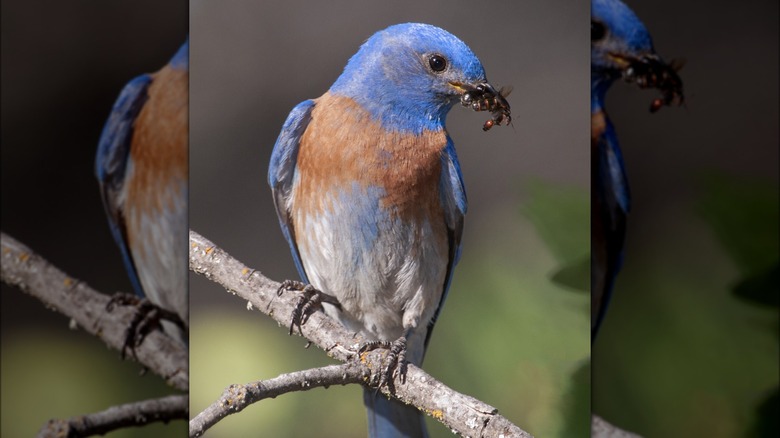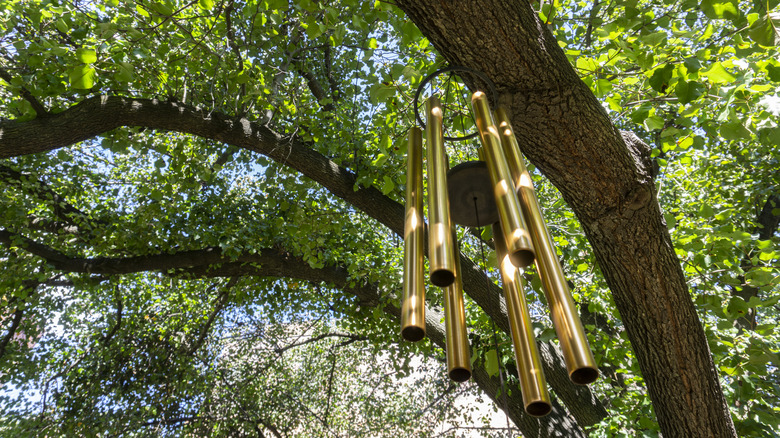Use These Tips And Tricks To Prevent Birds From Munching On Your Garden Fruit
Plenty of gardeners wax poetic about the perks of attracting birds to the garden. These natural works of art animate the landscape and the atmosphere with their colorful feathers and chirpiness. Making the most of their bird's eye view and sometimes driven by parental instincts, they clean up a yard's pesky weeds and insects with extraordinary precision. But these fair-weather friends become turncoats when the fruits ripen, competing with gardeners for the literal fruits of their labor. Leaving behind half-chewed berries — or worse, their poop splatters (who cares if it works as fertilizer in the heat?) — they make it necessary to explore methods to keep birds away.
Birds are adaptive creatures who switch their food preferences with the seasonally changing fruit profiles. They share a penchant for energy-giving lipids that grow in proportion to the fruits' maturity. They also love plucking off varieties high on anthocyanin, as they can see them better due to UV reflection. A winter food shortage can also cause these high flyers to peck dormant fruit buds. Regardless of the reasons, it's undeniable that your fruit trees need protection. Fortunately, there are multiple humane methods to deter birds from munching on your garden fruit. Netting, audio and visual scare devices, and repellent sprays are just a few. Use them in tandem for the best results.
Drape the fruity area in netting
Exclusionary techniques like casting a nylon net or row fabric over your short-statured fruit plants are the most effective way of keeping avian thieves away. After all, if the birds can't reach it, they can't eat it. To make this work, install the net on an elevated frame made of stakes or bamboo. Alternatively, leverage the adjoining fence posts or PVC pipes to hold the net. Ensure it covers the shrubs completely and tether it to the ground to keep it from blowing away. If required, use spacers to prevent it from touching the shrubbery, or the nibblers will use the net as a perch to chomp down on the fruits through the holes. But if you're feeling crafty, try a DIY dollar tree hack to keep birds out of your garden by repurposing your hula hoops.
Before buying a net, make sure it's worth your while. These items are expensive, but being durable, they're a good return on your investment within two years, especially if you lose almost half your fruit yield every year. But to achieve that, your net must be UV resistant or require frequent replacements due to sun degradation. Also, ensure its holes aren't wider than 1 centimeter to prevent injuring the birds who'll try to get through it anyway. That being said, draping and removing nets every season is time- and labor-intensive. Another downside is that they affect the airflow and may raise rodent populations since they keep out the raptors.
Dazzle the birds away with reflective items
Like humans, birds, too, feel uncomfortable with arbitrary light flashes, and you can capitalize on this to move the feathered pests along. The best part, though? You already have what it takes to rid your garden of pesky birds. Rummage through your storage, dust off some old compact discs (CDs) you haven't listened to in a while, and hang them from strings at differing heights from the trees you want to protect. Placing them close together will give you an added advantage, as the wind will have them clinking randomly, spooking the birds. But if you've already disposed of these '90s remnants, look for items in your kitchen, like aluminum foil or pie pans. Either wrap parts of the tree with foil or punch a hole in the pans and dangle them as you would the CDs. These noisy deterrents will even send squirrels and other troublesome mammals packing.
Alternatively, hang a reflective flash tape or Mylar streamers, especially if you're protecting cherries or apples. They're cheap and easy to use, albeit unattractive. However, they're unlikely to keep berry visitors like starlings, mockingbirds, house finches, and American robins at bay. Although the trick works well initially because the birds haven't made sense of the blinding reflections, the newness does wear off, and you may find birds using these items as a perch or weaved into their nests. But pairing the items with noisemakers can raise their impact.
Spook feathered thieves with faux predators
The oldest trick in the bird-scaring book is to place scarecrows in your fruit orchard. While you can go old-school, with grain sacks and flannel pants adorning a human-shaped dummy, commercial options are available, too. Some variants are also equipped with a sound system and inflate irregularly to give the illusion of a living being, raising their deterrence level. But if scarecrows aren't to your liking, you can instead deploy static silhouettes of owls or snakes around your precious fruits — the bigger, the scarier. From plastic models to inflatable ones, they come armed with several imposing features, such as flappy wings and fidgeting heads that shock the unsuspecting foragers.
Pest decoys exploit the birds' fear, causing them to flock to another location for self-preservation. Plus, they capitalize on their novelty to terrify the thieves — at least until they start figuring out the heads (or tails) of the fakes. However, they're most effective when you place highly realistic models, ideally in bright yellow or red shades, prominently in the birds' line of sight before they can experience your fruits' juicy sweetness. If possible, pop them on wind vanes or battery-driven rotors to give them movement. To prevent the birds from disregarding the decoys, reposition them every two to three days, and pair them with an audio repellent. However, regardless of your actions, this short-term fix will lose its effectiveness after a while.
Startle the birds with balloons and kites
If you don't find decoys a worthwhile investment, try out the relatively inexpensive scare-eye balloons or balls with large holographic eyes drawn on them. Suspend them from the fruit trees or adjoining poles, and let the breeze handle the rest. If required, dangle the balloons with a spring to boost their erratic movements. Better yet, tether hawk- or falcon-shaped kites to the ground or hang them with helium balloons and leave the avian pests guessing if they've entered the zones controlled by the loathed birds of prey. In bigger orchards, arrange them so that there's at least one kite per hectare.
This works because birds see the large eyes and believe they're being followed, so they scamper away to escape the "live predators." But if the positions remain unchanged for long, the birdy burglars will catch on that the threat isn't real. Further, these aerial elements aren't suitable in areas experiencing strong gusts (over 8 kilometers per hour), as they blow away easily and risk becoming tangled in trees or overhanging wires. Sun exposure, too, can deflate helium balloons, necessitating periodic refilling. Experiment with different sizes and colors to figure out what works in your garden, as their effectiveness varies across species. Complement their use with acoustic devices like those mimicking a bird's distress call to make them more effective.
Sabotage the avian thievery through audio assault
As sirens, cannons, firecrackers, and exploders signal danger to the beaked bandits, they're usually the first choice for gardeners looking to deploy noise deterrents. But if they make you uncomfortable, there are more benign options, like recordings of distress and alarm calls that mimic the species or their predators. Solar or battery-powered noise devices are another option that may also feature flashy lights or motion sensors and are hung above trees. You'll need one system for every five acres for meaningful results. However, as these systems emit mechanical whirring sounds, birds soon learn to differentiate the noise, decreasing their effectiveness over time. They're also a bother in urban, populated areas, as they shrill early in the morning when the pecking pests are active. In such instances, ultrasonic systems are a better call, as they're usually inaudible, making them less intrusive.
Noise deterrents work because the flash-harmonized earsplitting noises are typically sufficient to have the birds hit the road, provided they play out arbitrarily from frequently relocating sources and aren't repetitive. Since bird vocalizations and dialects matter, too, stick to playing recordings of species native to your area as well as the menaces threatening them. Also, look for frequency variations or experiment with multiple noisemakers when using bio-tones. Having said that, know they work better on adult rather than juvenile birds in the short term, with absolutely no impact on crows and magpies.
Leave them baffled with spinning devices
Other popular visual tactics to deter the avian adversaries of your garden fruit include garden spinners, miniature pinwheels, and tiny windmills. They're easy to use and look fairly attractive with their variety of bright shades, adding an ornamental touch to your garden. To add a dash of your personality, you can craft your DIY wind spinner, killing (not literally) two birds with one stone (or spinner). To get this trick to work, simply stand the spinners close to your fruity gems. But if the fruit trees are relatively large, plant the spinners on 6- to 10-foot-tall poles or PVC pipes. Alternatively, buy cheap pinwheels and snake decoys, mount them on stakes, and place them around your shrubbery right before the fruits ripen. This provides both visual (reflective surfaces) and auditory (spinning sound) benefits to the trick.
Spinning devices work like a charm because birds notice even the tiniest movements and are on alert when the wheels go round and round. Being bird-brained, they sometimes mistake the spinners for predatory movements. When it's windy, the noise helps to frighten them as well. However, birds are quick to collect their wits when the spinners remain stationary, so don't forget to move them around every time you come out to pluck the fruits. While the method isn't 100% foolproof, it can minimize the damage to some extent.
Redirect their attention to alternate food sources
You might give this one a side-eye, but it truly works. The feathery visitors swoop down to nibble on fruits because they're hungry (no points for guesses). So, once you provide them with a more appetizing meal just right for their palate, why would they gorge on the juicy pulp instead? The easiest way out is to mount fully stocked bird feeders far away from your fruit trees. Plus, the benefits of having a bird feeder may become obvious, as you begin to enjoy birdwatching, easily restoring the symbiotic relationship between the flock and you. It could backfire, however, if you slack on refilling the feeder, leaving you with a group of famished critters that you attracted to your yard in the first place.
This diversionary tactic works without a birdfeeder, too, as long as alternate food sources like corn or specific seeds (depending on the avian type), are on the menu. For the best results, put the food near the birds' nesting sites, provided they're far from the fruits. But if they aren't roosting in your yard, grow crops that ripen before your fruits do to habituate the birdies into feeding from that spot. Secure the site further with other decoy methods to drive your point home. An even better option is to grow more fruit. That way, you won't be distressed over the loss of some fruits as you'll have multiple sites growing.
Make them think again with repellent sprays
You can give birdy thieves the brush-off by spritzing chemical repellents. These deter birds with unpleasant tastes and odors. For instance, methyl anthranilate-containing repellents like Avian Control have shown positive results in small orchards, as the birds are aggravated by contact with it. This active ingredient is also present in grape-flavored Kool-Aid, making it a suitable spray repellent for berries, as the birds find their taste revolting. However, used alone, these sprays prove insufficient and require additional help, like an alternate food source to distract the flurry of creatures. Moreover, they must be reapplied throughout the harvesting season to retain their effectiveness. They are also unsuitable for blueberry crops because their residue causes leaf scalding.
Polybutene or aliphatic petroleum-based tactile repellents are available, too, although some are also made of natural plant compounds. When birds sit on the treated fruit, their feet feel sticky, which agitates them, causing them to scram. A 5% concentrated mix of thyme, cumin, and rosemary can effectively disperse starlings. However, these products break down under sunlight and may stain your fruits. Not to mention, repellent sprays can be expensive and aren't easy to apply. EPA recognized-Avitrol is another offering that, although promoted as a scaring agent, can turn lethal in higher dosages, so use caution.
Send them flocking over fishing line
Another inexpensive yet highly effective method to lessen bird invasions is monofilament fishing lines, which are pretty easy to use. Just prop a pole near your fruit trees, ensuring it's at least 2 feet higher than the trees' tops. Attach a line to the pole and extend it to the ground. Repeat the process around the tree by spacing all lines 2 feet from each other into the soil. Stake them for a better hold. Your final structure should resemble a conical tent. As fishing lines are prone to intertwining, never place them directly over the branches. Don't worry if some branches sit outside the lines, since birds are unlikely to come within a foot of the structure.
If you're wondering why this nearly invisible hack works for keeping birds away, the answer is still up in the air. Some experts believe that birds become anxious when they notice the line constantly appearing and disappearing. Since figuring out whether the barrier actually exists is too much of a hassle, birds simply fly away. Additionally, they may be concerned about getting caught between the fishing lines, making escape from predators difficult. However, these theories are unproven, as the lines are placed sufficiently apart to allow the birds to pass through without hiccups. That being said, this method doesn't work on all bird varieties, including starlings and robins, but seems to keep sparrows in check.
Turn on the laser light
Beam strobe lights, spotlights, or flashing lights on your fruit bushes if hungry birds remain persistent. The lights are easy to install and need little maintenance, but they do require a convenient power source. Keep the flash frequency under 100 per second and use blue lights, as birds are more sensitive to their wavelengths. While the exact reasons for the lights' effectiveness remain unclear, some believe it has to do with unfamiliarity. Plus, they're fairly disorienting when shone during lowlight feeding times (dusk till dawn). Some birds may, however, become used to them over time.
If so, switch over to pedestal-mounted green laser beams — they perform well in all light conditions. But red laser lights will suffice if you're mainly targeting nocturnal birds, as they only work in dim lighting. A 2002 research by the U.S. Department of Agriculture and National Wildlife Research Center found that in ambient lighting, laser wavelengths ranging between 630 and 650 nanometers were effective in scattering birds away without causing them or the environment any harm. Indeed, an 80-minute exposure was sufficient to disperse 96% of the Canadian geese present in the field. Lasers have a lasting impact because birds misjudge them as predatory movements, thereby steering clear of them. They've shown decent results with common problem birds like vultures, crows, and gulls. Moreover, Class-III B lasers work wonders on wild birds like waterfowl. Many manufacturers even customize the laser patterns for an orchard's specific conditions, which makes them expensive. Use caution since lasers can hurt human vision.
Shorten avian visits through habitat management
While constantly searching for the best scaring ploys, it isn't unusual to lose sight of the pivotal role played by habitat quality and management in dispersing pesky birds. But then again, it requires quite a bit of planning and labor. The goal is to design the landscape in such a way that birds lose interest in engaging with it. Similar to your list of birds that you don't want to see in your yard, birds have their lists, too. So, making the garden habitable for bird-deterrent species is one way to keep the avian thieves away. For instance, many orchard owners succeed in putting up nest boxes for American kestrels that feed on fruit-eating birds. At the same time, you can deliberately invite specific bird species like purple martins and bluebirds that aren't as disruptive, perhaps because they stick to insects, while working to keep marauders like mockingbirds off your property.
Rearranging where you plant fruit shrubs bears fruit, too. As currently understood, the damage is more significant if the fruit trees are grown around the edges of a garden, especially next to rows of non-fruit vegetation. Replacing them with low-maintenance hedges around the borders is sure to make the birds lose interest sooner than you think. You can magnify the benefits further by using native trees in hedgerows, as they'll attract better pollinators and pest controllers. Whenever possible, switch to fruit varieties that your daily visitors find relatively unappetizing.
Plant vegetation that sends birds on a detour
You can have rowdy birds make a beeline for greener pastures by planting flowers they dislike. For instance, daffodils are a no-no for foraging fowl because of the toxic lycorine compound present in them. Thus, planting daffodils next to your fruits (if they aren't competing) can quickly bar the winged creatures' entry. Similarly, some bird varieties dislike white flowers, so having them around works. Curiously, despite their tasty fruit, blackberry plants throw some birds off, thanks to their spiky foliage. But avoid growing them if starlings and silvereyes visit your garden often. Also, experiment with bird-resistant cultivars. A 2012 study in Plant Production Science found a few sunflower varieties that were left relatively untouched by the tiny oriental greenfinch — their routine attacker — because they couldn't manage to eat the bigger seeds.
You could also plant denser vegetation to block the birds' line of sight. For example, pigeons loathe wading through heavy thickets and can be held off by planting cabbages and related vegetables adjacent to your fruit shrubs. Growing tall grasses is another common tactic that plenty of gardeners fall back on, even though the impact varies across bird species. While not vegetation, another quick fix is to lay down a couple of sticks to disguise your seedlings, in addition to making it more difficult to access them. That being said, use this method in combination with other tactics like netting or scarecrows for a more solid deterrence effect.
Ward off birds with wind chimes
Not all sounds need to be grating on the ear — as is the case with noisemakers and distress calls — for them to repel birds effectively. Sometimes, all you need to achieve your bird-frightening goals is a sweet-sounding wind chime. Hang them around your treasured trees after carefully removing most (if not all) of the perch spots that birds love to sit on. This means cutting back certain branches and moving bird feeders to another location. You can also place them in your yard's corners by hooking them to a pole.
In contrast to humans, birds don't find the chiming sounds pleasing and would rather rush out of your fruit garden to save themselves from the annoyance. Unfortunately, they become accustomed to this stimulus and learn to disregard it after a while. So, to achieve better results, hang bigger wind chimes with loud tones that annoy the birdies deep in their souls. Also, add a visual element by going for chimes with shiny, metallic, or reflective surfaces that throw light flashes at the fowl as an additional warning. If you're repurposing an old pair of chimes, cover them with reflective tape. Remember, wind chimes are at the mercy of the winds to prove their worth, so ensure your area is sufficiently breezy; otherwise, there's no point in having them around. Keep moving them around every few days until you're done plucking all the ripe fruits.
